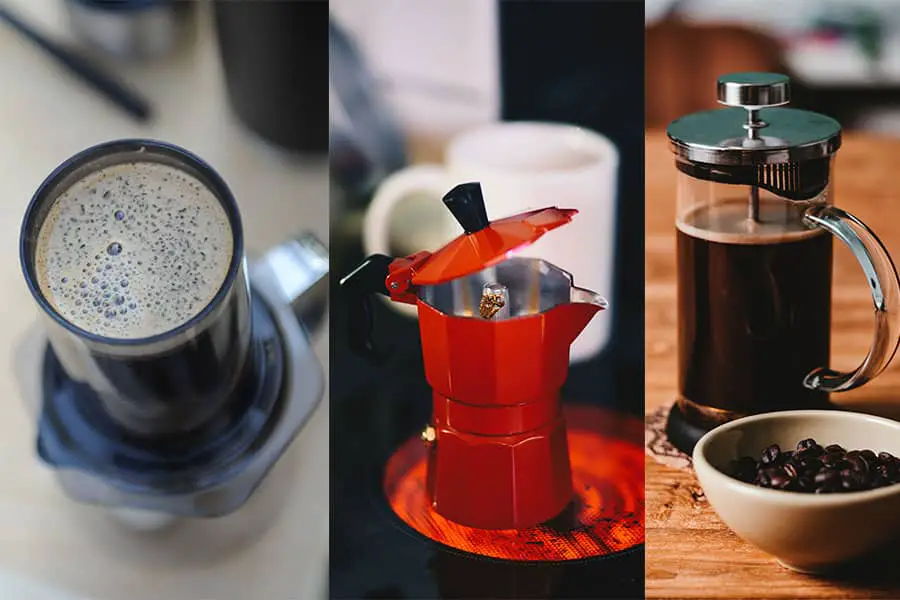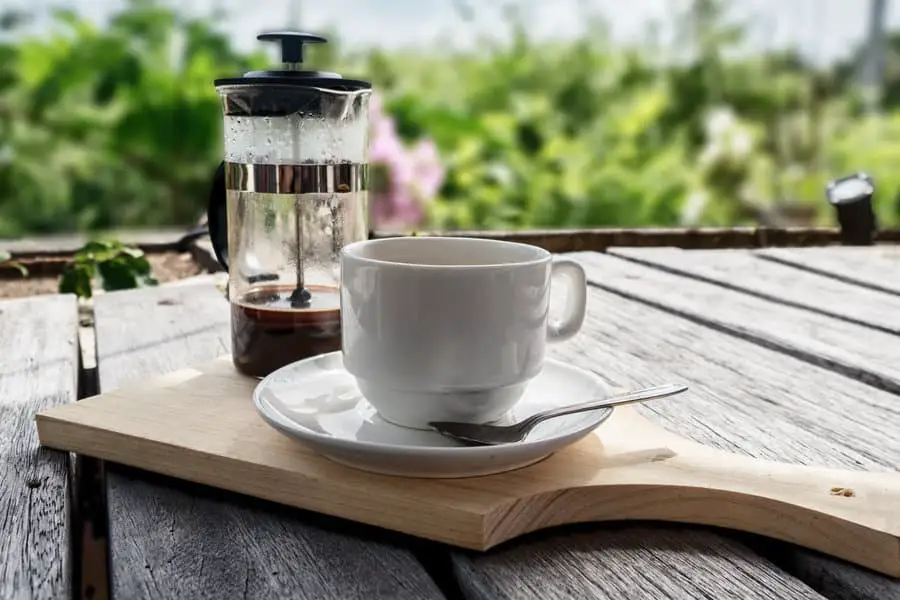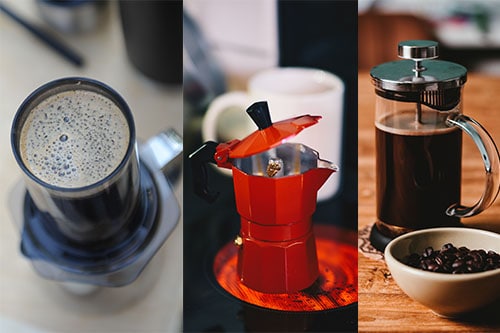
Coffee is loved and appreciated by many, regardless of whether it’s made the traditional quick-fix black, made with a drip coffee maker way or using the pour over method. But if you prefer a an espresso but don’t have a machine to make it with then I have some options for you.
In this article, I’ll go into detail with these 3 unique ways of making espresso without a machine at home or even if you are traveling. So, lets get started.
3 Ways to Make Espresso Without a Machine
Hearing this question for the first time will have many coffee addicts that love espresso thinking that it is an impossible thing . It is possible to make your favorite cup of espresso without using an espresso machine by using one ( or all ) of the following three methods.
1. Making Espresso with A French Press

A French Press is a rather simple technology but one that works amazingly well in the brewing of coffee You can get a French press for usually less than $30 from Bodum, but the price also depends on the size of the press. For those new to this type of brewer, the French press is more or less a container that resembles a thermos with a piston running through it in the middle from the lid.
Once you have a French press, the other things you need to make your cup of espresso is fresh ground coffee and hot water and the correct coffee to water ratio. With that, all you need to do is follow these easy steps:
Step 1. Grind your fresh roasted coffee
Ensure that you have the grinder ( a burr grinder) on a coarse setting. If you don’t have a grinder, then you can always go with pre-ground coffee but this is not ideal. What ever you do avoid using finely ground coffee.
If you do you will end up with a muddy cup of espresso because the mesh screen will not hold the fine grounds down. Use two tablespoons of coffee in the French press to make one cup of espresso or for those scientists try to use 7 to 1 ratio.. ( 7 grams of water to 1 Gram of Coffee)
Step 2. Add the hot water
I you used freshly roasted coffee, you will notice the coffee starts to produce a fantastic smell as it blooms. If the coffee grounds do not bloom, then your coffee is probably not fresh and your espresso will have less then the rich flavor it should have.
Now.. it won’t be bad, it just won’t reach it full potential. Also, try to use water that is 30 seconds off boil or if using a kettle with a temperature gauge, at between 195 – 205 Fahrenheit otherwise, you will have an espresso that will not reach the proper extraction since hot water at the right temperature is crucial to the perfect cup of the coffee or in this case, espresso.
Step 3. Gently stir the coffee grounds
Take care not to stir up the grounds as the object of the exercise ‘at this point is to start the extraction process. Once you do this let the coffee steep for 4 minutes.
If you don’t let the coffee steep and you start the coffee extraction you will not get a great espresso and you will need to start over. the steeping, you then proceed to press down on the piston gently and then retract it once it reaches the bottom of the container to press it down again.
And there you have it, your cup of espresso from a French press.
2. Making Espresso with the Aeropress
The Aeropress is more or less a modern version of the French press, having the same design and function principles. The machine has a cylinder with a piston and a filter on the lower end and another on the base cap.
But unlike the French press that works with coarse coffee grounds, the Aeropress uses medium fine ground coffee. Since you are using fine coffee grounds, you do not have to steep the coffee as is the case with the French press.
So how do you make espresso with the Aeropress? Just follow these simple steps.
Step 1. Grind your coffee beans to medium fine
If you use say a coarser ground coffee then they are too big and the hot water will flow freely through them, and the result is a cup of coffee that has a flat or maybe even sour taste.
Step 2 Place a filter on the base cap
Pour a bit of hot water on it before attaching it to the Aeropress tube. The hot water helps get rid of any unpleasant tastes that the filter paper may have.
Step 3. Add the coffee grounds and shake the cylinder
Even out the powder. Then place the second filter on the piston before you proceed to add hot water into the tube and place in the plunger.
Step 4. Press the plunger all the way down
Do this while having the Aeropress positioned over a cup. Press the entire amount of water from the tube through the base cap and take note the coffee puck.
If it is compressed and looks like a hockey puck, then everything is well. Add more hot water and repeat the process. Use two tablespoons of the fine ground coffee to make a cup of espresso.
If you would like additional recipes on how to make an espresso with an Aeropress, check out my other Aeropress Post or if you want to get one, go to Amazon to check out the latest price.
3. Making Espresso with a Moka Pot
For the novice coffee lover that takes a sip of espresso made using a Moka pot, what they usually get is something that knocks the socks right off their feet. In short, opting to use the Moka pot for brewing coffee is something for the ardent coffee lover not the faint-hearted. It is for that person what always looks forward to an intense cup of coffee in the morning.
It is a type of coffee maker that seems more “complex” compared to that of the French press. However in a very general sense, it works using the same principles of pressure as in the French press, but the pressure it generates is higher. So let’s see the steps in using a Moka Pot.
Step 1. Grind your coffee beans to have medium a grind
If need be, buy ready-made coffee grounds (not recommended) if you do not have a coffee grinder. You need the coffee to ground medium so that the highly-pressurized hot water passes through it more easily.
Step 2. Add Water to Base
Now, as you have probably noticed, the pot has a lower chamber in which to add the water (see my water and its effect on coffee post) where it will be heated when you place the pot on the stove. Make sure the valve that is inside of the chamber is not covered by water so that the pressure that builds up as the water boils can escape through it; otherwise, the pot may explode (not pretty).
Step 3. Fill the coffee basket with coffee
Do not overfill it or try to push in more than required; it will only result in being too compact and the result will be a bitter coffee that is over extracted. What you want is to have the water pass through the grounds with ease so that that the extraction so the coffee is properly extracted, giving you a flavorful cup of espresso.
Step 4. Put the Top Half On
At this point screw the top portion tight but not so hard that you’ll never be able to take it off! Then place it on the stove. It should be set on a medium to medium high heat so that pressure builds up gradually and the coffee flows through the sprout.
If you notice that the coffee starts to “blast” out when brewing than the means the stove temperature is too high and you will want to use a lower temperature then next time you brew
Step 5. Remove Moka Pot and let it Rest
Once you hear that bubbling sound, somewhat like you hear from a automatic drip coffee maker at the end of brewing, take it off the burner and let it set for about 30 seconds for the pressure to start to subside. If you want to go crazy you can set the moka pot on a cold cloth to stop the brewing process and avoid the chance of having over extracted coffee.
And there you have it, your cup of espresso from a Moka pot, so all you need to do now is sit back, sip and enjoy! I recommend you get the Bialetti, as that is the best that I have found that has the most consistent brewing. The prices are always changing so instead of giving you a certain prices, its just easier to check out prices on Amazon or a local store.
Final Thoughts
All the three methods I mentioned above will make a good espresso, you just need to decide which method you like the best or you find the easiest to do.
Keep in mind that ideally, you want to use roasted, freshly ground coffee beans as this has a large influence on the taste as you follow the steps of using any of the three methods mentioned above.
Also, when you brew the espresso for the first time and it does not come out as you would expect do not lose hope. It may just take a little practice and brewing a few more times before you get the brewing process down pat, but it should not be that hard to master if you stick to these guidelines.

